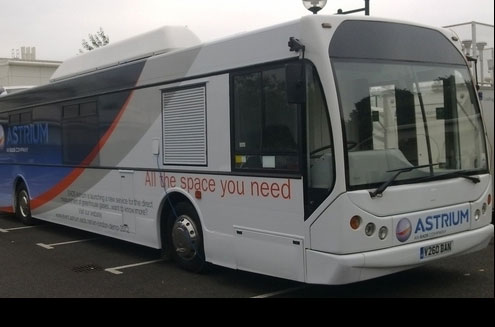| Nov 13, 2013 |
Improving analysis of greenhouse gas emissions
|
|
(Nanowerk News) The Centre for Carbon Measurement at the National Physical Laboratory (NPL) is partnering with Astrium Services to deliver a new emissions measurement service to enable countries and cities to better quantify their greenhouse gas (GHG) emissions.
|
|
This unique new service will provide actual measurements of carbon dioxide, methane and carbon monoxide that will be fed into a sophisticated atmospheric model to provide highly accurate analysis that complements existing reporting methods.
|
|
Emissions from a nation or a city are currently calculated using the 'inventory approach'. Through this activity, data - such as the number of miles driven by an average person - are multiplied by 'emissions factors' which turn that activity data into the tonnes of carbon dioxide equivalent.
|
 |
| The Astrium Bus comprises a meeting lounge for our guests and terminals to visualise the real-time green-house gases concentrations measurements.
|
|
The new service will complement and improve these methods by using actual emissions measurements taken from the atmosphere and integrating them into the models used to produce a value for country or city-wide emissions.
|
|
The measurements will be taken at permanent elevated sites round the country, from aircraft, and will eventually use satellite measurement of carbon dioxide too. These measurements will then be fed into the sophisticated model, to be merged with inventories of natural and manmade GHG sources and sinks. This combination of actual measurement with traditional modelling will enable better validation of energy saving and decarbonising measures and determine if they are having the intended effect of reducing actual GHG emissions.
|
|
NPL will produce the highest-quality calibration gas standards to underpin the quality of the data used in the service. This is important as data quality is critical when looking for small changes over a number of years.
|
|
Jane Burston, Head of the Centre for Carbon Measurement at NPL, said: "Nations are incentivising their citizens and industries to reduce their GHG emissions. They are putting in place alternative ways of generating energy with fewer emissions, such as biomass, shale gas, carbon capture and storage and nuclear energy. For these to be effective we need to be able to see the real local impact they have by measuring the reduction of GHG emissions in the areas around them. This is exactly what Astrium and NPL's new service will be able to provide, delivering confidence to local and national administrators and they people they serve."
|
|
Christèle Donadini from Astrium Services said: "Monitoring and controlling greenhouse gas (GHG) emissions is crucial at international, national and major city level, to both reduce the level of polluting emissions and to promote the uptake of green, low carbon technologies. This will become even more important as growing populations will make our future cities the primary contribution to man-made global climate change, and countries will need to implement robust strategies to report and reduce their carbon footprint."
|
|
London Pilot
|
|
As part of a pilot scheme for the new service, NPL, on behalf of Astrium, set up four sensors at elevated points across London to measure the concentrations of carbon dioxide and methane in the city's air.
|
|
The project combined these ground measurements from a network of four sensors with airborne measurements and space-borne data collection. On top of that, the Astrium Bus, a converted London bus, which housed a mobile GHG sensor, was driven around a fixed London route every day to detect GHG concentrations at road level.
|
|
The bus combined the various measurements to produce a real-time cityscape video of carbon dioxide and methane concentrations around central London. This produced 3-D visualisations of modelled emission sources over London, the UK and the world, showing how natural sources and sinks of carbon dioxide compared with man-made emissions over a cycle of days and weeks.
|


